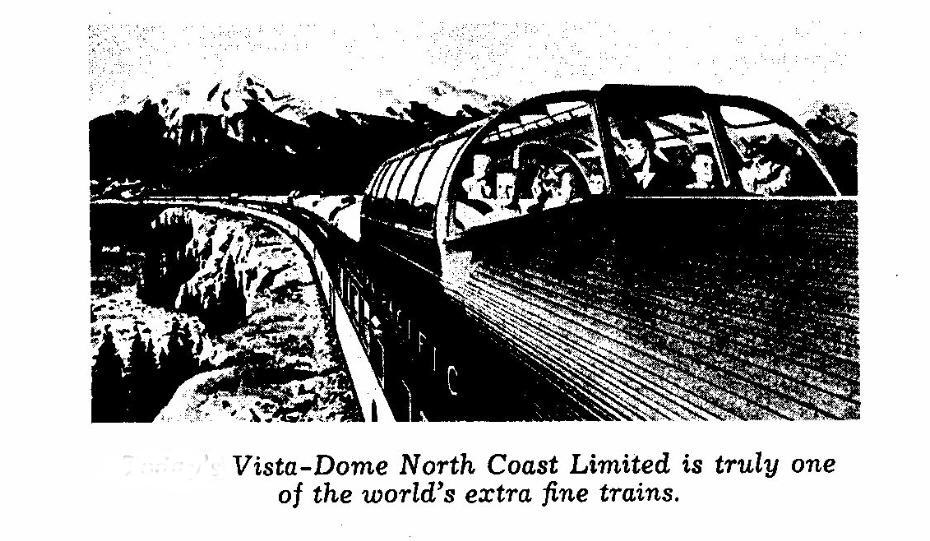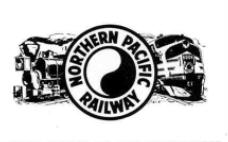
Later Developments
Two important events in NP's development took place in the early 1900's. The Northern Pacific and the Great Northern jointly purchased, in 1901, nearly all of the outstanding common stock of the Chicago,Burlington and Quincy, a great railroad system of some 11,000 miles. This afforded direct access and favorable routes to Chicago and the great markets of the Middle West and South. The Northern Pacific, also jointly with the Great Northern, built the Spokane, Portland and Seattle railroad between 1905 and 1909, a system now consisting of almost 1,000 miles of main line, which serves productive areas of Washington and Oregon. Luxurious lounge car on the North Coast Limited, 1900 the first electric lighted train in the Northwest.
To make its transportation service more flexible, the NP in 1932 organized a wholly-owned subsidiary, the Northern Pacific Transport company, to provide highway freight and passenger service as a motor common carrier and to supplement NP rail service. Its operations today are carried out in the states of Washington, Montana, Idaho, Wyoming, North Dakota, Minnesota and Wisconsin.
A major rehabilitation program was carried out during World War II and the following decade. About 2,000 miles of new and heavier rail was laid and extensive application of heavy ballast was made. More than 300 main line curves were eliminated or reduced, bridges and tunnels replaced and new shops and freight houses built.
First discovery of oil on NP land in the Williston Basin near Richey, Mont., on July 13, 1951, drew national attention to the Northern Pacific because of its extensive holdings of land and mineral rights in the Basin both in Montana and North Dakota. The discovery led to the formation by Northern Pacific in the following year of an oil development department with headquarters at Billings, Mont., to supervise development of this important resource.
Since the war, the Northern Pacific has taken advantage of rapid advances in technology to improve and modernize all phases of its operations. The railway pioneered in the use of radio in freight train operations and in the extensive use of continuous welded rail which almost completely eliminates rail joints and reduces maintenance costs. In 1955 the first modern "pushbutton" freight classification yard in the Pacific Northwest was completed at Pasco, Wash. It is ideally located for expeditious handling of increasing traffic from the Columbia Basin area where 1,000,000 acres will eventually be brought under irrigation by waters of the Columbia River impounded by Grand Coulee dam. NP rails serve 40 percent of this vast new and growing agricultural empire.
Traffic demands of World War II gave rise to the first installation of centralized traffic control in western Montana, completed in 1947. Since then, further installations of CTC help expedite traffic as do modernization in other areas such as mechanization of accounting operations and expansion and improvement of communications.

Early in 1958, 20 years after it had acquired its first diesel locomotive, the Northern Pacific had completely dieselized its motive power. Of all the post war changes, the diesel locomotive is the most familiar and dramatic example of the vast changes that have taken place in railroading,
In 1864, the Northern Pacific set out to conquer a wilderness. Slowly but surely the frontier was pushed back, and, with the passing of time, construction camps became great cities. Along the main line arc Duluth, Superior, St. Paul, Minneapolis, Fargo, Jamestown, Bismarck, Mandan, Glendive, Miles City, Billings, Livingston, Boze-man, Helena, Butte, Missoula, Spokane, Pasco, Yakima, Seattle, Tacoma, Vancouver and Portland—nearly all the great cities of the Northwest. For it was but natural and inevitable that the distribution and marketing centers of this vast territory would develop along the favored route of the first of the northern transcontinentals.
GN's first president, James J. Hill, attempted to merge GN and NP in 1893, only to have the merger denied by the U.S. government. In 1901, Hill again tried to merge the two railroads, this time with the CB&Q, but was turned down a second time. In fact, these railroads tried to merge four times (1893, 1901, 1927, 1961) before finally receiving ICC approval in 1970 that created Burlington Northern from GN, NP, SP&S and CB&Q on March 2, 1970.
A list of Northern Pacific presidents of the road from its beginning:
JOSIAH PERHAM December 7, 1864 to January 5, 1866 JOHN GREGORY SMITH January 5, 1866 to November 1, 1872 GEORGE W. CASS November 1, 1872 to April 23, 1875 CHARLES B. WEIGHT April 23, 1875 to May 24, 1879 FREDERICK BILLINGS May 24, 1879 to June 9, 1881 A. H. BARNEY June 9, 1881 to September 15, 1881 HENRY VILLAHD September 15, 1881 to January 4, 1884 ROBERT HARRIS January 17,1884 to September 20, 1888 THOMAS F. OAKES September 20, 1888 to October 19, 1893 BRAYTGN Ives October 20, 1893 to June 30, 1896 EDWARD D. ADAMS July 1, 1896 to July 21, 1896 EDWIN W. WINTER July 21, 1896 to August 31, 1897 CHARLES S. MELLEN September 1, 1897 to October 23, 1903 HOWARD ELLIOTT October 23, 1903 to August 27, 1913 JULE M. HANNAFORD August 27, 1913 to July 1, 1918 HOWARD ELLIOTT July 1, 1918 to February 29, 1920 JULE M- HANNAFORD March 1, 1920 to December 1, 1920 CHARLES DONNELLY December 1, 1920 to September 4, 1939 CHARLES E. DENNEY September 28, 1939 to December 31, 1950 ROBERT S. MACFARLANE January 1, 1951 to October 1, 1966 Louis W. MENK October 1, 1966 to March 2, 1970
Back 
Home